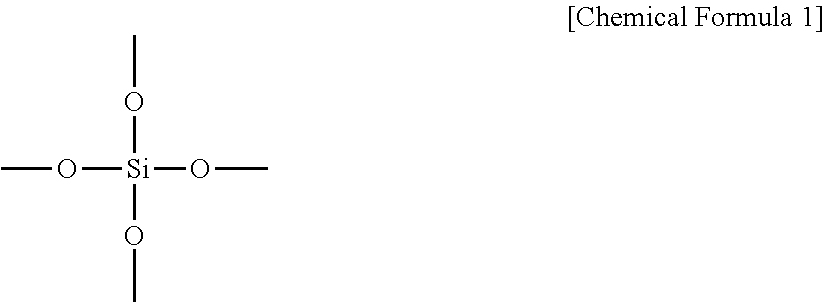Inorganic hydrophilic coating solution, hydrophilic coating film obtained therefrom, and member using same
a technology of hydrophilic coating and hydrophilic coating film, which is applied in the direction of catalyst activation/preparation, physical/chemical process catalysts, catalysts, etc., can solve the problems of poor durability of hydrophilic coating agents containing water-soluble polymers as the main component, and limited working conditions, so as to achieve excellent removability of adhered soiling, no substrate damage, and excellent transparency and hardness
- Summary
- Abstract
- Description
- Claims
- Application Information
AI Technical Summary
Benefits of technology
Problems solved by technology
Method used
Image
Examples
example 1
[0087]For the tetrafunctional silicon compound, a high-purity fumed silica (not a commercially available product, an amorphous silica manufactured by Shin-Etsu Chemical Co., Ltd. having a primary particle size of not more than 500 nm) having the properties shown in the table below (units: mass %) was used.
TABLE 1SiO2Fe2O3Total carbonMgOSO3Na2OK2OCaOP2O5Cl−99.040.010.030.100.008
[0088]The above fumed silica, water, and tetramethylammonium hydroxide (25 mass % aqueous solution, manufactured by Toyo Gosei Co., Ltd.) were mixed so that the ratio of silica : tetramethylammonium hydroxide=1:2 (molar ratio) and the silica content of the system at the start of the reaction was 5 mass %, and the mixture was then stirred under heating at 110° C. for 2 hours. The resulting solution was diluted with water to obtain a solid fraction concentration of 0.5 mass %, and was then adjusted to a pH of 7.0 using an ion exchange resin (product name: Dowex 50W-X8, manufactured by Dow Coming Corporation), th...
example 2
[0089]Tetraethyl orthosilicate (purity: 99.9 mass % or higher, manufactured by Tama Chemicals Corporation, hereafter sometimes referred to as TEOS), water, tetramethylammonium hydroxide (25 mass % aqueous solution, manufactured by Toyo Gosei Co., Ltd.) and acetone (manufactured by Wako Pure Chemical Industries, Ltd., special grade) were mixed so that the ratio of tetramethylammonium hydroxide: tetraethyl orthosilicate=4:1 (molar ratio), and so that at the start of reaction, the tetraethyl orthosilicate content of the system was 15 mass % and the acetone content was 42 mass %, and the mixture was then stirred at normal temperature for 5 hours, yielding a white precipitate. The solvent was removed from the system, the precipitate was recovered, and following washing with acetone, the precipitate was redissolved in water, diluted with water to obtain a solid fraction concentration of 0.5 mass %, and then adjusted to a pH of 7.0 using an ion exchange resin (product name: Dowex 50W-X8, m...
example 3
[0090]A photocatalyst Sagan Coat TO sol (product name: TO-85, a dispersion of Anatase-type titanium oxide, manufactured by Kon Corporation) was added to the coating solution of Example 1 in sufficient amount that the ratio of the solid fraction within the coating solution obtained in Example 1: TiO2=90:10 (mass ratio), thus preparing a coating solution.
PUM
| Property | Measurement | Unit |
|---|---|---|
| temperature | aaaaa | aaaaa |
| contact angle | aaaaa | aaaaa |
| particle size | aaaaa | aaaaa |
Abstract
Description
Claims
Application Information
 Login to View More
Login to View More - R&D
- Intellectual Property
- Life Sciences
- Materials
- Tech Scout
- Unparalleled Data Quality
- Higher Quality Content
- 60% Fewer Hallucinations
Browse by: Latest US Patents, China's latest patents, Technical Efficacy Thesaurus, Application Domain, Technology Topic, Popular Technical Reports.
© 2025 PatSnap. All rights reserved.Legal|Privacy policy|Modern Slavery Act Transparency Statement|Sitemap|About US| Contact US: help@patsnap.com

